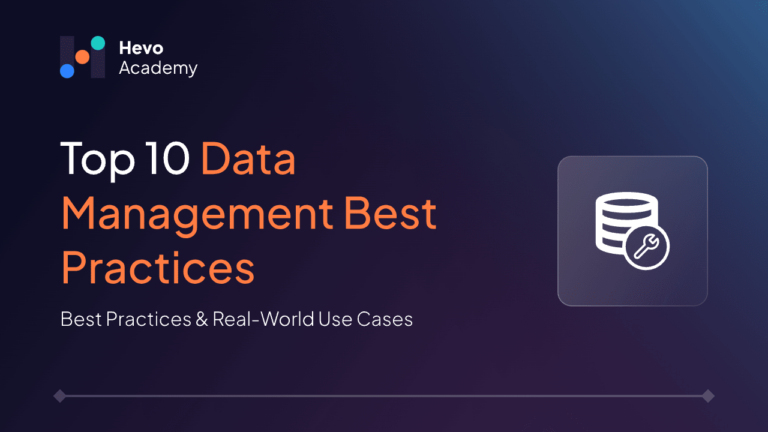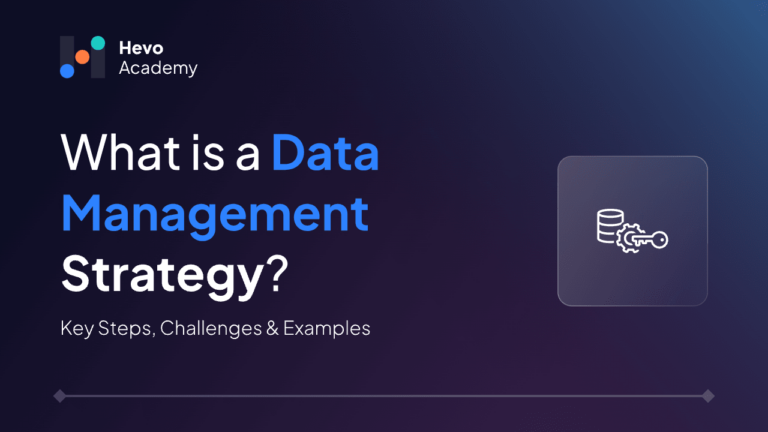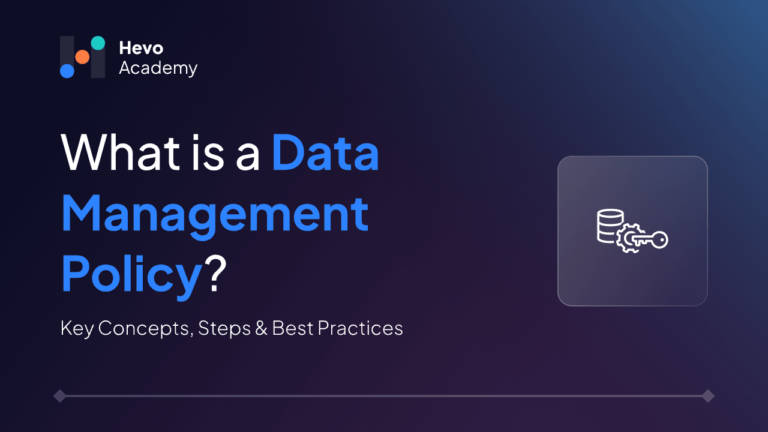Imagine a tremendous 328.77 terabytes of data produced every single day, and yet, with a lack of data integration, inhomogeneity, and security, the world suffers. How companies manage data in such a virtual age will make them successful in compliance and profitable, apart from having a grasp over new opportunities for growth. With increased data complexity, best practices can no longer become a matter of discretion. This blog covers data management best practices, their use, and their importance, which will allow companies to maximize storage, secure data, and transform raw data into a robust commercial asset.
Table of Contents
Top 10 Data Management Best Practices
Data perfection in management enables organizations to maintain accuracy in data with safe releases and accessible access avenues. Greater volumes of information and future high growth in the data field require best practices for maximizing operations and improving compliance and decision accuracy (Growth Report, 2030).
1. Establish Robust File Naming and Organization Standards
A well-defined file naming convention and hierarchical organization structure enhance data accessibility and prevent confusion. Organizations should implement consistent naming protocols, avoid ambiguous abbreviations, and use version control mechanisms to maintain clarity. Structured directories, automated indexing, and cloud-based repositories further optimize retrieval speed and collaboration.
2. Design Effective Metadata Management Practices
Metadata allows effective data access and governance through its core functionality. Automated metadata tagging in conjunction with contextual classification frameworks permits effective data retrieval for all users. AI-powered metadata platforms for enrichments detect duplicates and maintain compliance through lineage tracking and compliance with FAIR standards.
3. Centralize and Optimize Data Storage Systems
A decentralized model brings about redundancy and discrepancies. Scalability and high availability can be attained with cloud-based models like data lakes, hybrid stores, and file systems with distributed architecture. Auto-tiering, when utilized, keeps high-performance accessible information and stores infrequently accessed data at a cost-effective price tag. Automated audits for storing regularly can delete unnecessary files and make performance efficient.
4. Document Processes for Seamless Data Management
Standardized data documentation, together with workflow mapping, helps create consistency between different teams. Every organization needs to preserve data dictionaries along with lineage tracking and process documentation to achieve full transparency. The use of version-controlled repositories facilitates collaboration and minimizes errors that arise from misinterpretation of datasets.
5. Foster a Strong Data-Centric Organizational Culture
When organizations embed data-driven principles, their employees understand the importance of reducing responsible accountability and well-founded decision-making. Organizations should provide employees with training about data literacy, security protocols, and governance frameworks. Data-driven innovation develops best when IT personnel work together with business unit representatives as well as members from analytics teams.
6. Ensure Data Privacy and Compliance With Security Protocols
Organizations must implement strict access controls, encryption methods, and identity verification protocols because of changing data protection laws (GDPR, CCPA). Zero-trust architecture, role-based access control (RBAC), and real-time anomaly detection systems protect against cyber threats. Companies must conduct regular audits to verify they maintain compliance with industry standards.
7. Adopt Advanced Data Management Software Solutions
Organizations gain operational insights from automated data cleaning capabilities through AI tools, which operate alongside data management systems and provide real-time monitoring. Operation streamlining occurs when organizations integrate their operations with API-based integration platforms and ETL (Extract, Transform, Load) tools, as well as data warehouses. Companies need to assess data governance tools like Collibra and Talend to build better workflows.
8. Set Clear and Measurable Data Management Objectives
Prioritizing accuracy, together with both completeness and dependability for data, helps minimize mistakes and improve decision-making efficiency. Organizations must have inbuilt automated testing pipelines and AI-facilitated anomalous behavior discovery processes alongside scheduled processes for data cleansing. Having data quality KPIs in position aids in tracking performance effectively.
9. Develop a Comprehensive Data Governance Framework
Data governance structures with hierarchical frameworks instate compliance and accountability alongside integrity in relation to information. Organizations have to instate owner roles in data and craft uniform policies in governance audits. Governance frameworks powered by AI run operations of policy compliance in parallel to ensure security alongside compliance with legislation and laws. Organizations with a well-established structure gain enhanced trust and accuracy with enhanced risk management.
10. Implement a Rigorous Data Quality Assurance Program
The accuracy in data collection enables companies to make effective and efficient decisions through enhanced operational efficiency. Organizations must implement data validation rules in deploying an anomaly detection system with AI-cleansing tools utilized to discover discrepancies in datasets that can arise in datasets for companies. Periodical data profiling and processes of deduplication produce uniform correct datasets for companies.
The practice of data management is closely accompanied by the development of secure and expandable effective processes. Implementation strategies yield heightened compliance with improved decision-making and bring long-term data operations in complex virtual environments.
Why Are Data Management Best Practices Important?
1. Ensures Data Accuracy and Reliability
The combination of data errors and inconsistencies with repetitive information appears when organizations handle data poorly. Trustworthy data insights emerge from accurate data integrity through validation methods and governance frameworks associated with deduplication approaches.
2. Enhances Security and Compliance
Optimization of data workflows eliminates repetitive operations, and, as such, a level of efficiency is increased. Automated integration, storing, and retrieval processes reduce work through less operational expenses and increased productivity.
3. Improves Operational Efficiency
Optimized data workflows reduce redundancy and streamline processing. Automation in data integration, storage, and retrieval minimizes manual efforts, increasing productivity and reducing costs.
4. Supports Scalability and Future Growth
Increasing business expansion necessitates having effective control over big datasets in organizations. Governance structures with normalized frameworks and feasible storing capabilities enable efficient access and administration of data when environments are in a state of constant flux.
Real-World Use Cases of Data Management Best Practices
1. Healthcare – Ensuring Data Privacy and Compliance
Healthcare organizations apply secure data governance in compliance with GDPR and HIPAA requirements for processing patient information submissions. Patient confidentiality is preserved safely through approved access for medical care and diagnostics care through the use of access restrictions, encryption techniques, and real-time system audits.
2. E-Commerce – Optimizing Customer Data for Personalization
Amazon and Shopify maintain their operations through established data management systems and AI analytics models that track customer choices, purchase records, and website usage. The structured system enables organizations to create improved recommendation capabilities, which strengthen user involvement and business revenue performance.
3. Financial Services – Preventing Fraud with Data Quality Assurance
FinTech companies and banks operate data authentication systems and continuous audits that deploy anomaly identification technology to stop payment fraud. AI-powered fraud detection systems utilize structured data to track unreliable actions, which helps advance methods of risk evaluation.
4. Manufacturing – Enhancing Supply Chain Efficiency
International manufacturers can enhance stock tracking and supply chain route management by combining metadatabase systems, analytical forecasting, and risk management abilities. Automated data systems allow real-time supply chain monitoring, which delivers companies complete operational visibility to reduce costs and boost operational efficiency.
Formulate a clear data management strategy to drive effective decision-making, streamline workflows, and enhance data governance.
Conclusion
Data is only as valuable as the way it is managed. The blog explained essential data management best practices, including the arrangement of metadata and the implementation of governance protocols combined with automation and robust system security measures. It highlights the importance of these steps using relevant business cases alongside common industry-level obstacles.
Organizations can maximize operational efficiency, improve compliance, and improve decision-making by implementing these organized ideas. As data ecosystems continue to evolve, embracing scalable, secure, and intelligent data management frameworks will be crucial for businesses to stay competitive and harness the full potential of their data assets.
Ready to revolutionize your data management? Explore Hevo today and discover how our ETL platform can transform your organization. Book a personalized demo with us.
FAQs
1. What are the 5 steps to data management?
The five key steps include data collection, storage, processing, analysis, and governance. Organizations must ensure secure storage, efficient processing, and structured analysis while maintaining compliance with governance frameworks to enhance decision-making and operational efficiency.
2. What are the five C’s of data management?
The five C’s are Consistency, Compliance, Correctness, Completeness, and Connectivity. These principles ensure data integrity, regulatory adherence, error-free records, comprehensive datasets, and seamless integration across platforms for better accessibility and decision-making.
3. What are the three main processes of data management?
The three core processes are data governance, data integration, and data quality management. Governance establishes policies, integration connects disparate data sources, and quality management ensures accuracy, completeness, and reliability for business intelligence and analytics.






